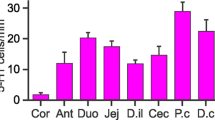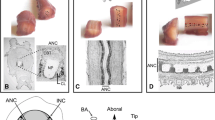Summary
In an attempt to identify duodenal endocrine cells emitting formaldehyde-induced fluorescence (FIF), chicken duodena were studied by combined fluorescence, ultrastructural, silver impregnation and immunohistochemical methods in the same or consecutive sections. Our results show that: (1) Almost all the cells emitting yellow fluorescence by both the Falck-Hillarp and the Furness methods exhibit an immunohistochemical reaction with serotonin (5-HT) antiserum. (2) Almost all cells radiating yellow fluorescence by the Furness method stain with toluidine blue in Epon-embedded sections but, by high-voltage electron microscopy, can be subdivided into two types of cell containing either small round or polymorphous types of granules. (3) In the sections from which resin had been removed, all the cells emitting yellow FIF show argentaffinity by the Singh method, but not all cells display argyrophilia with the Grimelius method. (4) Cells exhibiting both argyrophil and argentaffin reactions in deresined serial sections are also separated into two types of cell, containing either small spherical or polymorphous types of granules by conventional electron microscopy in thin sections. Therefore, chicken enterochromaffin cells emit yellow FIF, store 5-HT, show both argentaffinity and argyrophilia, but are ultrastructurally classified into two types of granule-containing cells which may be related to polypeptides coexisting with 5-HT.
Similar content being viewed by others
References
Abercrombie M (1946) Estimation of nuclear population from microtome sections. Anat Rec 94:239–247
Ahlman H, Bhargava HN, Dahlström A, Larsson I, Newson B, Pettersson G (1981) On the presence of serotonin in the gut lumen and possible release mechanisms. Acta Physiol Scand 112:263–269
Alumets J, Håkanson R, Sundler F, Chang KJ (1978) Leu-enkephalin-like material in nerves and enterochromaffin cells in the gut. An immunohistochemical study. Histochemistry 56:187–196
Andrew A (1976) Intestinal endocrine cells of chicks around the time of hatching. Cell Tissue Res 172:541–551
Barter R, Pearse AGE (1953) Detection of 5-hydroxytryptamine in mammalian enterochromaffin cells. Nature 172:810
Dey RD, Hoffpauir J (1984) Ultrastructural immunocytochemical localization of 5-hydroxytryptamine in gastric enterochromaffin cells. J Histochem Cytochem 32:661–666
Erspamer V, Asero B (1952) Identification of enteramine, the specific hormone of the enterochromaffin cell system, as 5-hydroxytryptamine. Nature 169:800–801
Facer P, Polak JM, Jaffe BM, Pearse AGE (1979) Immunocytochemical demonstration of 5-hydroxytryptamine in gastrointestinal endocrine cells. Histochem J 11:117–121
Falck B, Hillarp NÅ, Thieme G, Torp A (1962) Fluorescence of catechol amines and related compounds condensed with formaldehyde. J Histochem Cytochem 10:348–354
Forssmann WG, Grube D (1971) Studien über die endokrinen Zellen des Magendarmtraktes. I. Histotopographische, fluoreszenzmikroskopische und ultrastrukturelle Untersuchungen an Katze und Ratte. Z Zellforsch 140:535–550
Furness JB, Costa M, Wilson AJ (1977) Water-stable fluorophores, produced by reaction with aldehyde solutions, for the histochemical localization of catechol and indolethylamines. Histochemistry 52:159–170
Grimelius L (1968) A silver nitrate stain for α2 cells in human pancreatic islets. Acta Soc Med Uppsala 73:243–270
Häkanson R, Owman Ch, Sjöberg NO, Sporrong B (1970) Amine mechanisms in enterochromaffin and enterochromaffin-like cells of gastric mucosa in various mammals. Histochemie 21:189–220
Heitz Ph, Polak J, Timson CM, Pearse AGE (1976) Enterochromaffin cells as the endocrine source of gastrointestinal substance P. Histochemistry 49:343–347
Hoyt RF, Jr., Sorokin SP, Bartlett RA (1979) A simple fluorescence method for serotonin-containing endocrine cells in plastic-embedded lung, gut and thyroid gland. J Histochem Cytochem 27:721–727
Ikeda H, Inugai H, Gotoh J (1971) Localization of monoamine containing fibers and cells in the alimentary canal of chickens. Jpn J Vet Sci 33:187–193
Inokuchi H, Kawai K, Takeuchi Y, Sano Y (1982) Immunohistochemical demonstration of EC cells in rat gastrointestinal tract. Histochemistry 74:453–456
Inokuchi H, Kawai K, Takeuchi Y, Sano Y (1983) Identification of EC cells in the human intestine: A comparative study between immunohistochemical and silver impregnation techniques. Histochemistry 79:9–16
Kataoka K, Shimizu K, Yamamoto T, Ochi J (1979) Monoamine containing cells in the gastric mucosa of the kitten: A new method employing comparative fluorescence and electron microscopy on identical cells. Acta Histochem Cytochem 12:383–390
Kobayashi S, Fujita T, Sasagawa T (1970) The endocrine cells of human duodenal mucosa. An electron microscope study. Arch Histol Jpn 31:477–494
Kobayashi S, Iwanaga T, Fujita T, Yanaihara N (1980) Do enterochromaffin (EC) cells contain motilin? Arch Histol Jpn 43:85–98
Larsson LI (1984) Evidence for anterograde transport of secretory granules in processes of gastric paracrine (somatostatin) cells. Histochemistry 80:323–326
Larsson LI, Jørgensen LM (1978) Ultrastructural and cytochemical studies on the cytodifferentiation of duodenal endocrine cells. Cell Tissue Res 194:79–102
Lundqvist M, Wilander E (1984) Small intestinal chromaffin cells and carcinoid tumours: A study with silver stains, formalininduced fluorescence and monoclonal antibodies to serotonin. Histochem J 16:1247–1256
Mayor HD, Hampton JC, Rosario B (1961) A simple method for removing the resin from epoxy-embedded tissue. J Biophys Biochem Cytol 9:909–910
Mourre C, Calas A, Gonella J (1981) Radioautographic study of uptake and storage of indolamines in the rabbit enterochromaffin cells. Neurosci Lett 23:251–256
Nichols DB, Cheng H, Leblond CP (1974) Variability of the shape and argentaffinity of the granules in the enteroendocrine cells of the mouse duodenum. J Histochem Cytochem 22:929–944
Nihei K, Iwanaga T, Yanaihara N, Mochizuki T, Fujita T (1983) Preproenkephalin A occurs in the enterochromaffin (EC) cells of the porcine intestine: An immunocytochemical study using antisera to met-enkephalin-arg6-gly7-leu8 and to serotonin. Biomed Res 4:393–398
Penttilä A (1966) Histochemical reactions of the enterochromaffin cells and the 5-hydroxytryptamine content of the mammalian duodenum. Acta Physiol Scand 69 [Suppl] 281:5–77
Penttilä A (1968) Enterochromaffin cells in the chicken duodenum during prenatal development. Z Zellforsch 91:380–390
Penttilä A (1969) Identification of enterochromaffin cells in adjacent Epon-embedded sections at light and electron microscopic levels. Z Zellforsch 102:193–204
Rubin W, Schwartz B (1983) Identification of the serotonin-synthesizing endocrine cells in the rat stomach by electron microscopic radioautography and amine fluorescence. Gastroenterology 84:34–50
Sano M (1975) Electron microscope study of endocrine cells and tumor cells in the glandular stomach of Praomys (Mastomys) natalensis. Arch Histol Jpn 38:237–258
Sato T (1968) A modified method for lead staining of thin sections. J Electron Microsc 17:158–159
Singh I (1964) A modification of the Masson-Hamperl method for staining of argentaffin cells. Anat Anz 115:81–82
Sjölund K, Sandén G, Håkanson R, Sundler F (1983) Endocrine cells in human intestine: An immunocytochemical study. Gastroenterology 85:1120–1130
Sokolski KN, Lechago J (1984) Human colonic substance P-producing cells are a separate population from the serotonin-producing enterochromaffin cells. J Histochem Cytochem 32:1066–1074
Sternberger LA (1979) Immunocytochemistry. 2nd ed. PrenticeHall Inc, Englewood Cliffs, New Jersey
Sundler F, Alumets J, Håkanson R (1977) 5-hydroxytryptamine containing enterochromaffin cells: storage site of substance P. Acta Physiol Scand [Suppl] 452:121–123
Toner PG (1964) Fine structure of argyrophil and argentaffin cells in the gastro-intestinal tract of the fowl. Z Zellforsch 63:830–839
Vassallo G, Capella C, Solcia E (1971) Endocrine cells of the human gastric mucosa. Z Zellforsch 118:49–67
Author information
Authors and Affiliations
Rights and permissions
About this article
Cite this article
Watanabe, T., Chikazawa, H., Chungsamarnyart, N. et al. Serotonin-storing cells of the chicken duodenum: light, fluorescence and electron microscopy, and immunohistochemistry. Cell Tissue Res. 247, 25–32 (1987). https://doi.org/10.1007/BF00216543
Accepted:
Issue Date:
DOI: https://doi.org/10.1007/BF00216543




